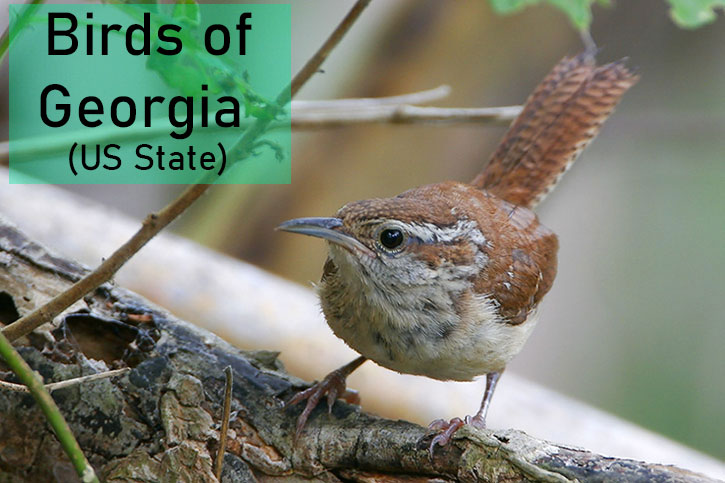
Georgia is a haven for hundreds of different bird species. But do you know, what are the most common birds of Georgia?
Based on data, in this article, we’ll take a look at some of the more recognizable and well-known birds in Georgia, especially those that can be found close to home.
So let’s take a look at the most common backyard and wild birds in Georgia and learn a little bit about them.
On this page
- Most Common Birds in Georgia
- Northern Cardinal
- Carolina Wren
- Tufted Titmouse
- Carolina Chickadee
- Blue Jay
- Red-bellied Woodpecker
- American Crow
- Mourning Dove
- Downy Woodpecker
- Eastern Bluebird
- Northern Mockingbird
- Eastern Towhee
- House Finch
- Eastern Phoebe
- American Robin
- White-breasted Nuthatch
- Brown-headed Nuthatch
- Chipping Sparrow
- Pine Warbler
- Brown Thrasher
- American Goldfinch
- Yellow-rumped Warbler
- Song Sparrow
- Turkey Vulture
- Red-shouldered Hawk
- Frequently Asked Questions about Birds of Georgia
Most Common Birds in Georgia
According to eBird data for 2022-2023, these are the most common bird species in Georgia.
Northern Cardinal
Most Popular Bird of Georgia
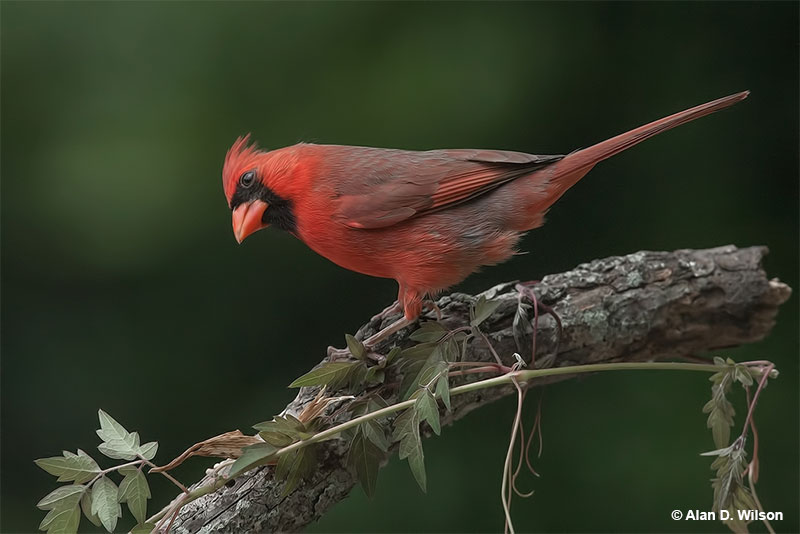
Scientific name: Cardinalis cardinalis
Length: 8.75 inches
Weight: 1.6 ounces
Wingspan: 12 inches
Song: “pichew-pichew-pichew, chew,chew,chew,chew,chew”
Northern Cardinals are medium-sized songbirds with a perky crest and big orange-red beak. Males are bright red with a black throat and face, and have dusky red on their back, wings, and tail.
Female Northern Cardinals are grayish-brown and buff with some black on their face and throat. They also have red highlights in their crest, wings, and long, rounded tail.
These common backyard birds have short, rounded wings and seem to bounce up and down as they move through the air. In flight, Northern Cardinals also make sharp chip notes.
Key Identifications:
- Crested bird with a conical orange-red beak and a black face. Males are red, females are grayish-brown and buff.
- Forages for seeds and insects on and near the ground. They like sunflower seeds at feeders.
- Makes a cup-shaped nest in bushes and low trees.
- Sings a clear, whistled song of repeated notes. They can sound like “cheer, cheer, chew, chew, chew, chew” or a quick “birdee,birdee,birdee,birdee,birdee“. They also make loud, sharp chip notes.
Northern Cardinals are one of the most beautiful common birds in most states, including Georgia. It’s no wonder seven different states chose it to be their official bird. Another fun fact about this species is that female Northern Cardinals also sing. They sing while sitting on the nest and may do so to tell their mates to bring food or warn them about predators.
Carolina Wren
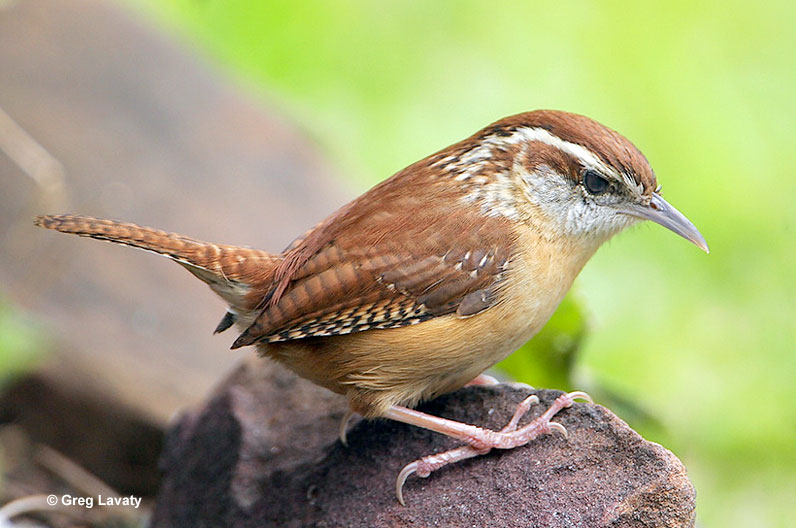
Scientific name: Thryothorus ludovicianus
Length: 5.5 inches
Weight: .74 ounces
Wingspan: 7.5 inches
Song: “teakettle, teakettle, teakettle”
The Carolina Wren is a small, reddish-brown and buff bird with a long, sharp, slightly decurved beak. It has a long, narrow, white eyebrow, a white throat, and some white mottling on its face. Males and females are similar and have black barring on their short wings, long tail, and under the tail.
Juveniles are similar but have paler underparts. This animated and vocal little bird forages for bugs in vine tangles and other dense vegetation. It usually occurs in pairs that can easily hide in the dense vegetation they prefer.
Carolina Wrens are very common birds in Georgia. They build a domed, cup nest made of sticks and soft vegetation. There is a side entrance and it can be placed in cavities and crevices of stumps, bushes, trees, potted plants, and other structures.
The Carolina Wren lives in vegetated gardens, second growth, parks and similar habitats in much of the eastern USA, parts of southern Ontario, and parts of eastern Mexico.
Key Identifications:
- Small reddish-brown and buff bird with a long beak and long white eyebrow.
- Feeds on arthropods in dense, tangled vegetation.
- Makes a domed cup nest with a side entrance in crevices, tree cavities, and human-made structures.
- Carolina Wrens fill the garden with loud and melodious songs. One common song sounds like, “teakettle, teakettle, teakettle“. They also make trilled sounds and harsh, nasal calls.
The Carolina Wren is a vocal species of gardens and second growth. Pairs use their long beaks to catch bugs and insects and aren’t shy about nesting near people. Many of these friendly birds have nested in such places as old shoes, potted plants, and abandoned cars.
Tufted Titmouse
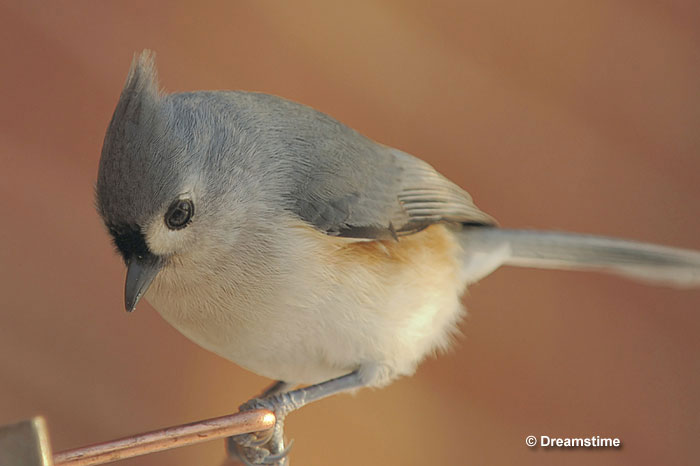
Scientific name: Baeolophus bicolor
Length: 6.5 inches
Weight: .75 ounces
Wingspan: 9.75 inches
Song: “peter peter peter”
The Tufted Titmouse is a small, crested, blue-gray bird with a white face. Males and females look the same and have a small black mark above their stubby black beak. They also have pale underparts with peach-orange flanks.
These cute little birds occur in small groups that forage for insects and seeds in parks and woodlands. They move through the trees and use their bills to pick food from leaves, bark, and branches. Tufted Titmouse are also regular visitors to bird feeders.
These small popular birds in Georgia nest in woodpecker holes and other cavities in dead trees, and can also use nest boxes.
We find the Tufted Titmouse in hardwood forests and forested urban areas. They are often heard before they are seen, and flock with other small birds. When they see a predator, they are some of the first birds to harass it.
The Tufted Titmouse occurs in the eastern USA and some parts of southeastern Canada.
Key Identifications:
- Small, crested blue-gray bird with pale underparts and a white face.
- Feeds on seeds and insects and visits feeders.
- Nests in tree cavities and nest boxes.
- The Tufted Titmouse is a very vocal bird. It gives constant whistled calls over and over, “peter peter peter“.
The Tufted Titmouse is an easily recognized bird that lives in parks, gardens, and woodlands. It occurs in small flocks, often visits feeders, and needs dead trees or nest boxes to breed. This species lines its nest with mammal hair including fur from Raccoons, Opossums, and other animals.
Carolina Chickadee
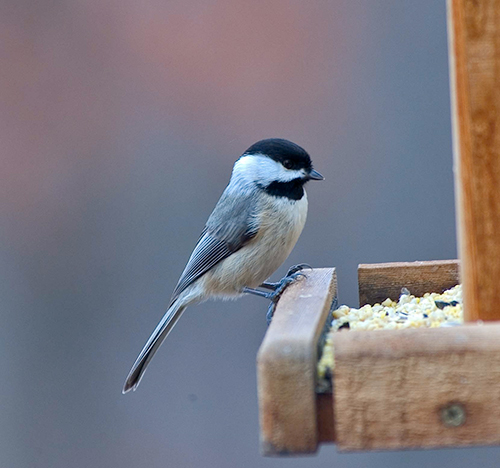
Scientific name: Poecile carolinensis
Length: 4.75 inches
Weight: .37 ounces
Wingspan: 7.5 inches
Song: “see-dee, see-dew”
The Carolina Chickadee is a small, cute, grayish and buff bird with a black cap, black throat, and white face. Males and females look the same and have stubby black beaks, strong, blue-gray legs and feet, and some pale edging on the feathers in their wings and tails.
This small bird mostly feeds on insects and seeds. It finds food by foraging with flocks of other small birds and picking small bugs and other items from bark, foliage, and twigs. Carolina Chickadees often hang upside down from twigs while foraging and are regular visitors to bird feeders.
These fun little birds nest in tree cavities and nest boxes, and live in parks, woodlands, and other habitats. As long as enough trees are present, they also commonly live in urban areas.
The Carolina Chickadee is a permanent resident from Maryland and Ohio west to Texas and south to northern Florida.
Key Identifications:
- The Carolina Chickadee is a small gray and buff bird with a smart black cap, black throat, and white face.
- Feeds on small insects and seeds. A regular visitor to bird feeders.
- Nests in tree cavities and nest boxes.
- Carolina Chickadees are vocal birds that make nasal “chick a dee dee dee” calls, and a high-pitched, “see-dee, see-dew”.
They usually occur in small flocks that forage for insects and seeds as they chatter and move through woodlands and park-like habitats and are common visitors to backyard bird feeders. This species uses its excellent memory to recall where it keeps hidden bits of food.
Blue Jay
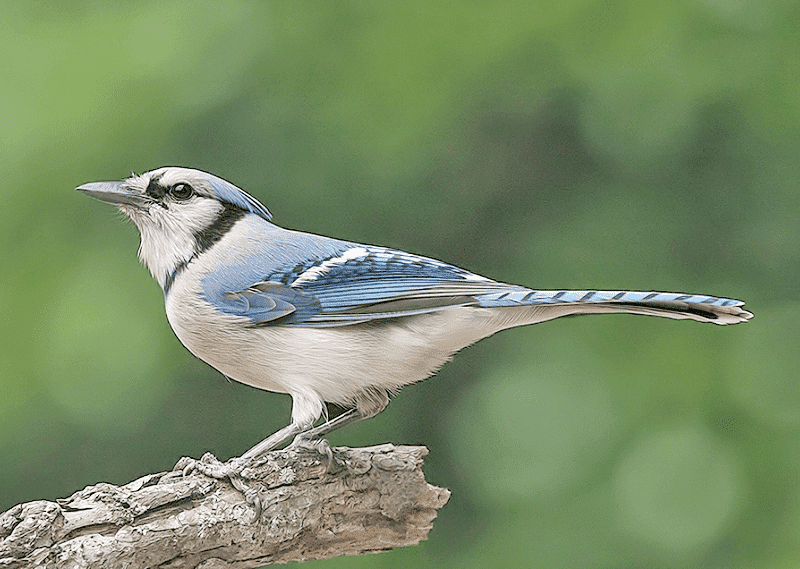
Photograph © Alan Wilson.
Scientific name: Cyanocitta cristata
Length: 11 inches
Weight: 3 ounces
Wingspan: 16 inches
Song: “Nyeah! Nyeah! Nyeah!”
The Blue Jay is a fairly large, crested bird with a straight black bill. Both sexes look alike and are blue above and gray and white below. They also have some small black lines on their faces and a narrow black necklace that goes up to the side of their face and crest.
Blue Jays also have some white markings and black barring in their wings and on their tail. Young birds look like adults but are duller blue.
They make messy cup nests at various heights in a variety of trees.
These social and intelligent birds feed on acorns, nuts, insects, and other small creatures. Like other members of the jay and crow family, they eat the eggs and nestlings of other birds.
The Blue Jay is a common bird of woodlands, forest, and towns east of the Rocky Mountains in the USA and central and southern Canada.
Key Identifications:
- Crested, fairly large bird with bright blue above and gray below.
- Feeds in trees and at feeders. Eats acorns, nuts, insects and many other food items.
- Makes a messy cup nest of sticks in a tree.
- Very vocal. In flight, Blue Jays often call as they swoop through the trees. They make a variety of sounds and mimic some other birds. Common calls include a nasal and complaining “Nyeah! Nyeah! Nyeah!” and various whistled calls.
The Blue Jay is a common, intelligent, and noisy bird. They make their presence known with their loud calls and can visit feeders. Ironically, when communicating with each other at close quarters, this species makes much softer and quieter calls. It’s almost as if they are talking with each other!
Red-bellied Woodpecker
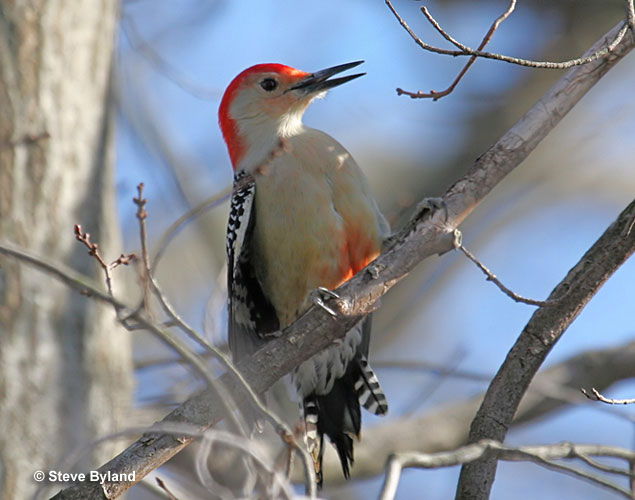
Scientific name: Melanerpes carolinus
Length: 9.25 inches
Weight: 2.2 ounces
Wingspan: 16 inches
Song: “Qwerr!”
Red-bellied Woodpeckers are medium-sized with black and white barring on their back and wings. They have a long beak and pale gray underparts with a small red patch on the belly.
Males have red on the head from the bill to the back of the neck (the nape). Females have an orange-red spot above their bill and red on the back of their head. Both sexes have a mostly white rump and central tail feathers.
This woodpecker species has long wings and “undulating” flight where it moves up and down as it flies. In flight, Red-bellied Woodpeckers show a small white patch in their wings.
The Red-bellied Woodpecker lives in wooded habitats. It eats nuts, seeds, insects, fruit, and can attack nestlings of other species. It also visits bird feeders.
This striking woodpecker occurs in pairs and nests in tree cavities high above the ground. It is the most common woodpecker in Georgia.
Key Identifications:
- Grayish woodpecker with black and white barring above, and red on the top of the head and back of the neck.
- Forages for seeds, nuts, insects and other food on trunks and branches.
- Nests in a tree cavity, high overhead.
- Makes a loud exclamation, “Qwerr!“. It also makes other, briefer and quieter “chug” calls.
Red-bellied Woodpeckers are common and adaptable birds. As long as big trees are present, we see them in urban areas as well as wilder places. They also visit feeders and have a very long tongue. When extended, it sticks out 2 inches past the tip of its bill!
American Crow
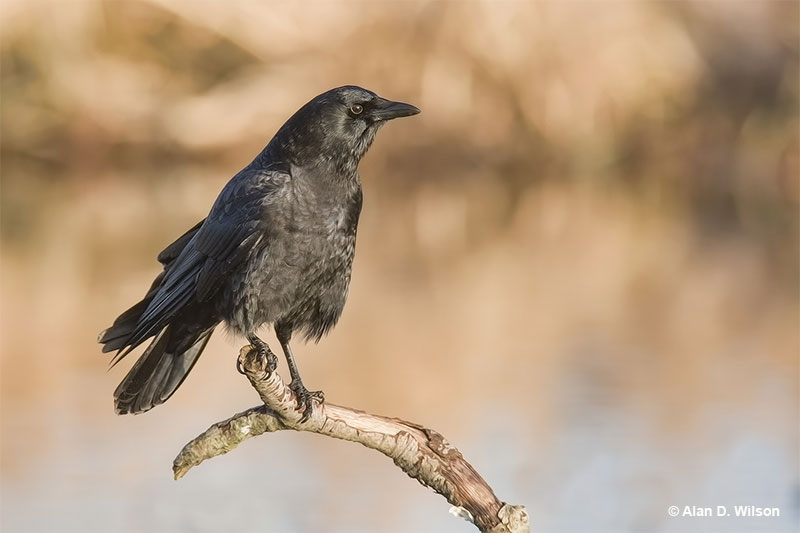
Scientific name: Corvus brachyrhynchos
Length: 17.5 inches
Weight: 1 pound
Wingspan: 39 inches
Song: “Caw! Caw!”
The American Crow is a big, all black bird with a strong, stout bill. In certain lighting, it can have metallic purple and blue iridescence.
Both sexes look the same and have some feathering on their beaks, long, broad wings, and a broad tail.
American Crows have direct flight with strong, steady wing beats. Crows are very social and intelligent birds that are usually seen in flocks. They forage together on the ground or in trees and eat just about anything they can find.
Some of their more regular foods include carrion, fruit, nuts, seeds, insects, and small animals. Like most jays and crow species, they also eat the eggs and nestlings of other bird species.
This species builds bulky stick nests high in trees and lives in most habitats except for high mountains and arid zones.
The American Crow occurs in southern Alaska and much of Canada and the USA.
Key Identifications:
- Big, all black bird with long, broad wing and a broad tail.
- Forages for carrion, fruit, seeds, insects, and small animals.
- Builds a bulky stick nest high in a tree.
- American Crows are very vocal birds. They can make several calls but their most common one is, “Caw! Caw! Caw!”.
The American Crow is a common, large black bird that frequently calls, “Caw! Caw! Caw!”. It usually occurs in flocks and lives in all sorts of places, even marshes. These birds are very smart and have funerals or wakes! When a crow dies, other crows mark the occasion by gathering together and loudly calling.
Mourning Dove
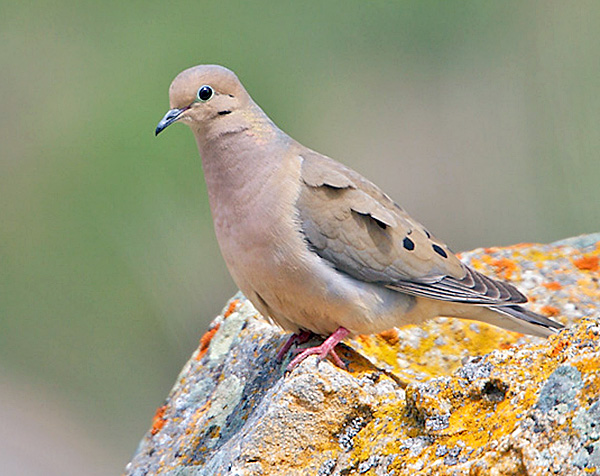
Photograph © Greg Lavaty.
Scientific name: Zenaida macroura
Length: 12 inches
Weight: 4.2 ounces
Wingspan: 18 inches
Song: “hooOOA, hoo, hoo, hoo”
Mourning Doves are medium-sized, grayish-brown doves with long tails. They have small black spots on their wings and a small head with a slender, dark beak.
Males and females also have narrow gray eyerings, a black mark on the face, and pale iridescent gold on the sides of their necks. They look alike except for males having more gray on the head and neck, and more iridescence.
This dove has fairly long wings and swift, direct flight. When flying, it shows black and white in its tail.
The Mourning Dove occurs in woodlands, gardens, on farms, and in urban areas. This common feeder visitor eats seeds and grains. It also forages in open situations, picking food from the ground.
This pleasant dove species can visit a feeder on its own or forage in small flocks. It builds an unkempt stick nest in bushes and trees and is very common throughout the USA, southern Canada, and Mexico.
Key Identifications:
- Plain brown and gray dove with a long, pointed tail.
- Feeds on seeds at feeders and on the ground in open areas.
- Makes a small, messy nest of sticks in trees.
- Sings a sad and owl-like “hooOOA, hoo, hoo, hoo”.
The Mourning Dove is the common garden dove in most of its range. It often visits feeders and its cooing song is commonly mistake for an owl. This species has a short lifespan with many adults only living for a couple of years or less.
Downy Woodpecker
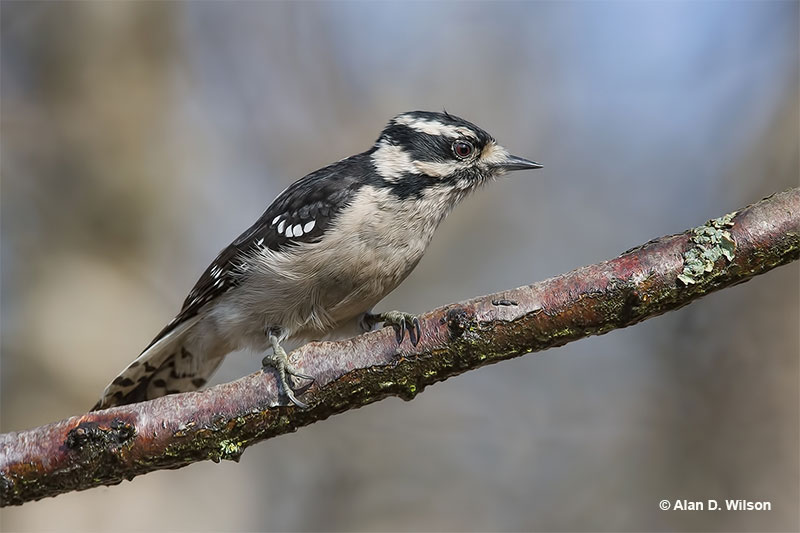
Scientific name: Dryobates pubescens
Length: 6.75 inches
Weight: .95 ounces
Wingspan: 12 inches
Song: “Pik! Ch,ch,ch,ch,ch,ch,ch!”
The Downy Woodpecker is a small black and white woodpecker with a short, black beak. They are patterned black and white above and have white backs and white underparts. Both sexes look alike except that males have a small, bright red patch on the top back part of their head.
Young birds look like adults but have a reddish patch on the top of their head. Downy Woodpeckers also have a few small black marks in their white outer tail feathers, and a small white tuft at the base of their beak.
This woodpecker eats insects, other small creatures, seeds, and small fruits. It pecks into live and dead wood and often forages on smaller branches and twigs. These friendly little woodpeckers are also common feeder birds.
They nest in tree cavities and live in gardens and a wide variety of woodlands. We see Downy Woodpeckers in much of Canada and the USA but not in arid habitats.
Key Identifications:
- Smallest woodpecker in North America. Mostly black and white with a short, black beak.
- Forages on trees, in bushes, and at feeders for insects, seeds, and suet.
- Nests in tree cavities.
- The Downy Woodpecker makes sharp “pik!” calls and also has a trilled call, “Ch,ch,ch,ch,ch,ch,ch!“.
Downy Woodpeckers are the smallest woodpecker species in North America and usually occur in pairs. They can also forage with other small birds and often visit feeders. This species takes advantage of its size to peck into the stems of weeds and other plants too small for larger woodpeckers to perch on.
Eastern Bluebird
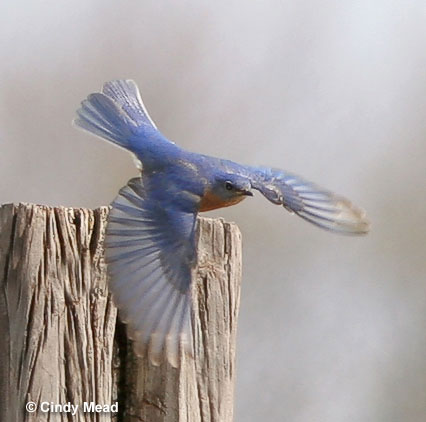
Scientific name: Sialia sialis
Length: 7 inches
Weight: 1.1 ounces
Wingspan: 13 inches
Song: “fer fer chidip fer”
The Eastern Bluebird is a rather small, blue and white bird with orange on the side of its neck, throat, breast, and flanks. The male has beautiful pastel blue upperparts, and a white belly and undertail.
Females have blue-gray upperparts, a broken white eyering, and some white on the throat.
Juveniles are gray-brown with some blue and pale spotting.
The Eastern Bluebird feeds on insects, fruit, and occasional seeds. It snatches insects in flight, picks them from leaves while hovering, and flies down to meadows and grassy areas to catch them on the ground.
Flocks of Eastern Bluebirds feed on small fruits by perching in fruiting trees and picking them from vegetation.
Eastern Bluebirds make a shallow cup nest out of grass inside a tree cavity or nest box.
This beautiful bird lives in open and semi-open habitats in southern Canada and the USA east of the Rocky Mountains. They also live in mountains in Mexico and northern Central America (including Georgia).
Key Identifications:
- Smallish blue and white bird with orange on their throat, breast, and flanks.
- Forages for insects and small fruit.
- Makes a shallow cup nest out of grass in a nest box or tree cavity.
- Has short melodious calls, “jeer” and a song of similar melodious notes, “cheweer chewit cherwit”.
The Eastern Bluebird is a smallish, blue and white thrush with orange highlights. They live in open and semi-open areas, and, in winter, form flocks that feed at fruiting trees. Eastern Bluebird populations have been boosted in many areas by “Bluebird Trails”; areas with nest boxes designed for this species.
Northern Mockingbird
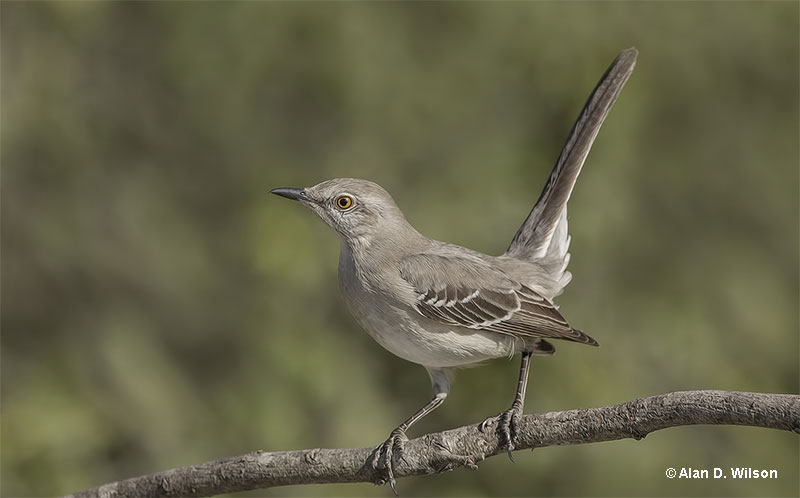
Scientific name: Mimus polyglottos
Length: 10 inches
Weight: 1.7 ounces
Wingspan: 14 inches
Song: “kerdee, kerdee, kerdee…jirdle,jirdle,jidrle…”
The Northern Mockingbird is a pale gray and white bird with a long tail. Around the same size as an American Robin, it has a dark line through a pale eye, a short, slender beak, and two white wing bars.
Both sexes look alike, are gray above, and white and buff below. In flight, this bird shows a blackish tail with white outer feathers and a big white wing patch.
Northern Mockingbirds feed on insects and berries. They forage in open grassy spots, on the ground.
The Northern Mockingbird lives in towns, parks, and other semi-open habitats, and builds cup nests in bushes and low trees. Northern Mockingbirds are common garden birds in much of the eastern and southern USA, southern Ontario, and Mexico.
Key Identifications:
- Vocal, gray and white bird with a small bill, white wing patches, and a long, black and white tail.
- Feeds on the ground in open areas and in bushes. Mostly eats insects and berries.
- Makes a cup nest in a bush or low tree.
- Very vocal. Sings many phrases and mimics many other birds. Some of the more regular phrases sound like, “kerdee, kerdee, kerdee…jirdle,jirdle,jidrle…“. These are interspered with the calls of Blue Jays, woodpeckers, Tufted Titmouse, and various other bird species.
The Northern Mockingbird is a common and conspicuous bird. They are often seen on lawns and sing from rooftops. This species can mimic the calls of 35 bird species as well as mechanical sounds. More than a century ago, these avian virtuosos were highly prized as a cagebird and were traded for large sums of money.
Eastern Towhee
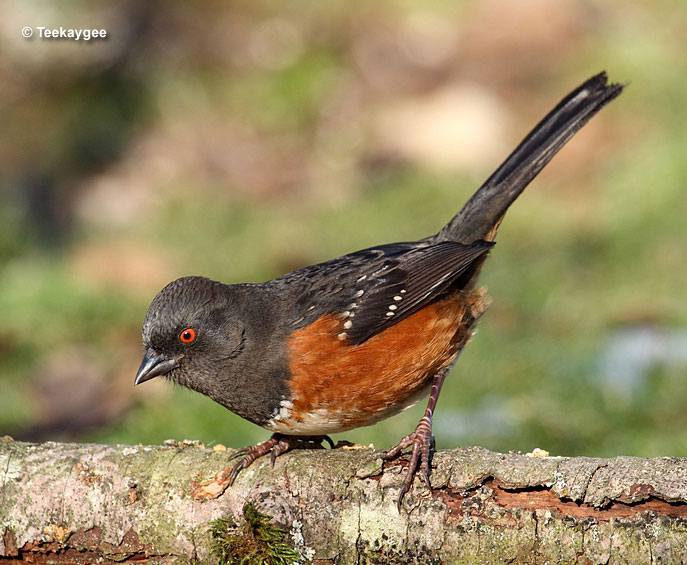
Scientific name: Pipilo erythrophthalmus
Length: 8.5 inches
Weight: 1.4 ounces
Wingspan: 10.5 inches
Song: “drink your TEA!”
The Eastern Towhee is a thrush-sized, boldly patterned, sparrow-like bird with red-brown eyes and a black, finch-like beak. It is dark above, has a small white patch in the wing, and a white belly with chestnut flanks.
It also has buff on its undertail, and white spots under its longish, rounded tail. Males have black upperparts and a black hood while these parts on females are dark brown. Young birds are dark brown and heavily streaked. They also have a pale wing patch and a buff undertail.
Eastern Towhees forage for insects and seeds by scratching and tossing leaf litter with both feet. This species also feeds on berries, especially during the winter months.
The Eastern Towhee uses grass and other plant matter to make an open cup nest in dense vegetation, on or near the ground.
Eastern Towhees frequent dense second growth and brushy habitats east of the Rockies in southern Canada and the eastern USA (being one of the most common birds of Georgia).
Key Identifications:
- Medium-sized, boldly patterned bird with a dark hood, small white wing patch, and chestnut flanks.
- Forages for insects and seeds on the ground, in leaf litter beneath and next to dense second growth.
- Builds an open cup nest in dense vegetation, near or on the ground.
- Quite vocal makes a brief jay or cat-like call, “neah”, a “short rising “week!” sound, and sings a distinctive song with a trilled note at the end, “Drink your TEA!”.
Eastern Towhee pairs forage for seeds and insects in leaf litter. Brown-headed Cowbirds often lay eggs in Eastern Towhee nests, but this doesn’t seem to have a big effect on their populations.
House Finch
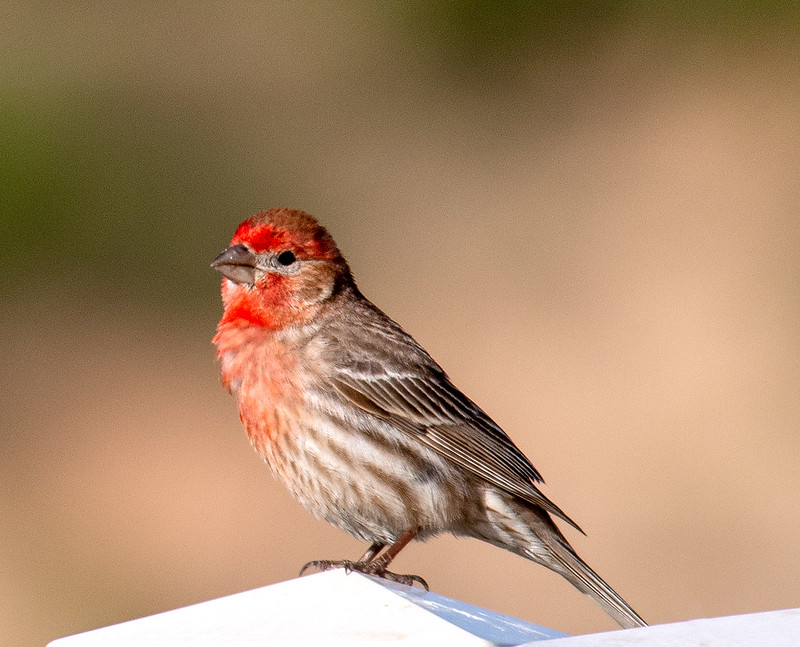
Photograph © John Hansen
Scientific name: Haemorhous mexicanus
Length: 6 inches
Weight: .88 ounces
Wingspan: 10 inches
Song: “chip,chip,chiprididip,ZREEYachip”
House Finches are sparrow-sized birds with dark, rounded beaks and fairly long wings. Males are orange-red or rose-red on their head, throat and breast, and have some red on their rump. They also have brownish streaks on their back, flanks, and white belly.
Like the male, female House Finches have two white wing bars on long, gray-brown wings. However, they lack red and are mostly streaked, dull brown-gray birds.
House Finches feed on seeds, buds, fruit, and flowers. They often visit feeders in Georgia but also forage on the ground, and in bushes and trees.
We see these pretty birds in deserts and arid zones, and in parks, farmland, urban areas, and other semi-open habitats.
The House Finch makes a soft cup nest built on a tree, building ledge or other spot with some overhanging cover. They often occur in small groups and live in southern Canada, most of the USA, Mexico, and Hawaii.
Key Identifications:
- Reddish or plain gray-brown, streaked, sparrow-like bird.
- Eats seeds, flowers, buds, and fruit. Can visit feeders but also forages on the ground and in bushes and trees.
- Makes a soft cup nest in trees, on building ledges, and other places.
- The House Finch often makes a soft, “fidip” call. Males also sing a warbling song from prominent, high perches. It sounds like, “chip,chip,chiprididip,ZREEYachip”.
House Finches are sparrow-like, reddish or brownish, streaked birds. They live in arid zones as well as in parks and urban areas. All of the millions of House Finches that live east of the Rocky Mountains are descendants of birds released on Long Island in 1939.
Eastern Phoebe
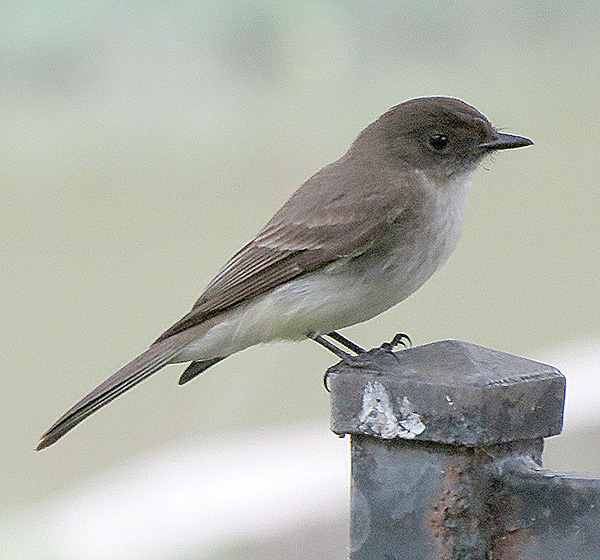
Photograph © Sam Crowe.
Scientific name: Sayornis phoebe
Length: 7 inches
Weight: .7 ounces
Wingspan: 10.5 inches
Song: “see-BEE! See BIDIT”
The Eastern Phoebe is a small to medium-sized, plain flycatcher that is dark, brownish gray above, and white below. It also has gray on its breast and a long, blackish tail constantly wagged up and down.
This bird also has a blackish head and some pale edging on long, dark wings. Males and females look alike but young birds have pale yellow bellies.
This flycatcher uses its slender beak to snap up insects. It catches them by flying from a perch and snatching them in flight, from foliage while hovering, and from the ground.
We usually see Eastern Phoebes on their own, sitting on low or medium-height perches. They make cup nests of mud, moss, and leaves on rocky outcrops, and under bridges and other structures.
This species breeds in woodlands and parks in Canada and the eastern USA, and winters in similar habitats the southeastern USA and Mexico.
Key Identifications:
- Plain, mid-sized flycatcher that is dark brownish-gray above and pale below with some gray on the breast.
- Perches low to mid-height in woodlands and flies out to catch insects. It also feeds on berries in winter.
- Makes a cup nest of mud and vegetation on structures and rocky outcrops.
- Sings a song that sounds like its name, “see-BEE! See BIDIT”.
The Eastern Phoebe is a featureless flycatcher with dark upperparts and pale underparts. It often wags its tail up and down and sallies from perches to catch insects. In 1804, this species became the first bird to be banded in North America when John James Audubon put silvered thread on an Eastern Phoebe’s leg.
American Robin

Photograph © Tom Grey
Scientific name: Turdus migratorius
Length: 10 inches
Weight: 2.7 ounces
Wingspan: 17 inches
Song: “cheery, cheery, cheery, cheery, cheer, cheer”
The American Robin is one of the most popular birds of Georgia. It is a familiar and common thrush that is dark gray above and brick red below. It also has an orange-yellow bill, a blackish head with white markings around the eyes and on the throat, and a white belly.
Both sexes of this thrush species are similar but males are darker above and more reddish on the underparts. Young American Robins have more white marks on their faces and spotting on orange underparts.
In flight, this common thrush in Georgia also shows white corners in its outer tail feathers.
American Robins forage on the ground for worms, insects, snails, and other small creatures. In winter, these common birds flock together and perch in trees and bushes to eat berries and fruit.
Key Identifications:
- Fair-sized songbird that is dark gray above, and brick red and white below.
- Forages for worms and bugs on lawns and other open grassy areas, also flocks together to feed on fruiting trees in the winter.
- Makes a cup nest in trees.
- The American Robin is quite vocal and makes a loud, sharp, “yenk!” call and quieter “check,check,check” calls. It also has a lovely cheerful song of caroled phrases, “cheery, cheery, cheery, cheery, cheer, cheer”.
The American Robin forages for worms and bugs on lawns and other open, grassy spots, and also eats berries. Populations of the American Robin have been estimated at 370,000,000; a number that gives this bird the distinction of being the most numerous landbird in North America.
White-breasted Nuthatch
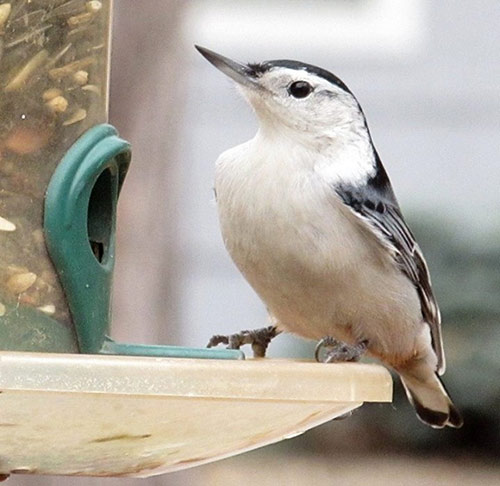
Scientific name: Sitta carolinensis
Length: 5.75 inches
Weight: .74 ounces
Wingspan: 11 inches
Song: “wehn wehn wehn wehn wehn wehn wehn wehn”
The White-breasted Nuthatch is a sparrow-sized bird with a longish, sharp, slightly upturned beak and a short black and white tail. It also has long wings, is mostly blue-gray above, and white and gray below with some chestnut on its belly and undertail.
Both sexes look similar and have a white face but males have a black cap and nape. Females have gray on their head and nape.
This small bird forages for insects, nuts, and seeds by creeping along branches and going down trunks, head-first. It uses its beak to pick food items from bark and also visits feeders.
The White-breasted Nuthatch makes a cup nest out of grass and soft bark inside a tree cavity or nest box.
White-breasted Nuthatches live in various wooded habitats in parts of southern Canada, most of the USA, and mountains in Mexico. They are frequent visitors to gardens near woodlands.
Key Identifications:
- Sparrow-sized, short-tailed songbird that is blue-gray above, mostly white below, and has a longish, slightly upturned beak.
- Creeps on branches and down tree trunks for insects, nuts, and seeds. Also visits feeders.
- Uses grass and soft bark to make a cup nest in a tree cavity or nest box.
- Quite vocal and makes nasal calls “yank yank”, and sings a nasal, laughter-like song, “wehn wehn wehn wehn wehn wehn wehn wehn”.
White-breasted Nuthatches are small blue-gray and white birds with slightly upturned beaks. They creep down trees in many wooded areas and are regular visitors to feeders. This species prefers to forage in flocks with chickadees and titmouse species because they are good at finding food and quick to make alarm calls when they see a predator.
Brown-headed Nuthatch
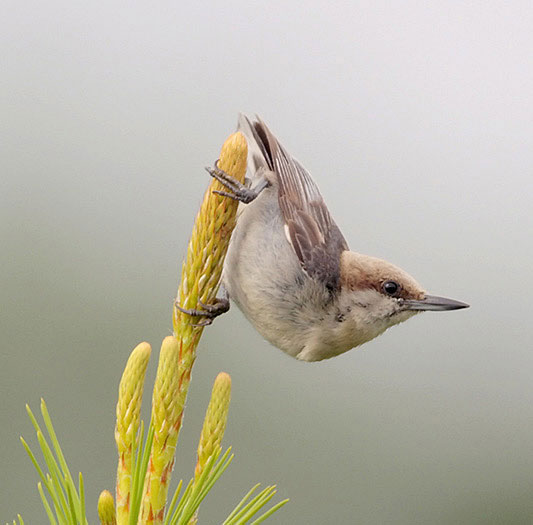
Scientific name: Sitta pusilla
Length: 4.5 inches
Weight: .35 ounces
Wingspan: 7.75 inches
Song: “cheechew! cheechew!”
The Brown-headed Nuthatch is a very small, short-tailed bird with a longish, sharp beak and a brown cap. Males and females look the same and have a white spot on their brown nape. The rest of their upperparts are blue-gray, and their underparts are white, buff, and pale gray.
Brown-headed Nuthatches feed on insects and seeds. Groups of this species forage with each other and other small birds and find food by creeping along branches and picking up food items with their beaks.
The Brown-headed Nuthatch is one of the most popular birds of Georgia. It nests in cavities in dead trees, often high above the ground. It lines its nest with some feathers, soft bark, cotton, and other soft materials.
This species lives in pine forest and mixed pine and hardwood woodlands in the southeastern USA. It is a permanent resident from eastern Texas and Arkansas east to North Carolina and north in coastal areas to southern Delaware. It requires wooded areas with dead trees.
Key Identifications:
- Tiny, short-tailed bird with blue-gray upperparts, pale underparts and brown on its head.
- Creeps along branches to forage for insects and seeds.
- Uses soft bark, cotton, and feathers to line a cavity in a dead tree, often high above the ground.
- Quite vocal and sounds like a squeaky rubber duck toy, “cheechew! cheechew!”.
Brown-headed Nuthatches are tiny blue-gray and pale birds with short tails and brown on their heads. They flock together and with other small birds in pine forests. This species can reveal hidden insects by taking a small piece of bark and using it to pry up pieces of tree bark.
Chipping Sparrow
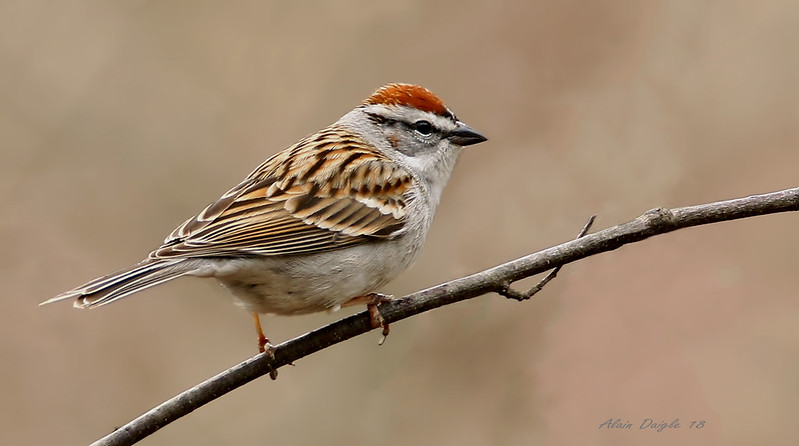
© Alain Daigle
Scientific name: Spizella passerina
Length: 5.5 inches
Weight: .42 ounces
Wingspan: 8.5 inches
Song: “titititititititititititti”
The Chipping Sparrow is a small, brown and gray sparrow with a longish, slightly forked tail and a conical bill. In summer, it has a rufous cap, white eyebrow, and dark line through each eye.
Males and females look the same and have small white crescents above and below the eyes, a pale brown back with dark streaks, gray rump and underparts, and pale brown wings with two pale wing bars.
In fall and winter, Chipping Sparrows are duller, have brown and buff heads, a gray rump, and a dark line through their eyes.
This species forages on the ground for insects and small seeds in open, grassy areas near conifers.
Chipping Sparrows use grass, hair, and other materials to make a cup nest low in a bush or small tree.
These sparrows live in parks, open woodlands, and on golf courses in much of Canada, most of the USA, and parts of Mexico.
Key Identifications:
- Small, slender sparrow with a rufous cap and white eyebrow in summer and a brown and buff head, gray rump, and dark line through their eyes in the winter.
- Forages for insects and seeds on the ground in grassy habitats with pines.
- Uses grass and animal hair to make an open cup nest low in a bush or small tree.
- Makes short chip notes and has a mechanical sounding, trilled song, “titititititititititititti”.
The Chipping Sparrow is a small and slender sparrow with a rufous cap and pale eyebrow. They are common birds of golf course and other similar, semi-open habitats and flock together during the winter. Chipping Sparrows eat more than 70 times their own weight in seeds, every winter!
Pine Warbler
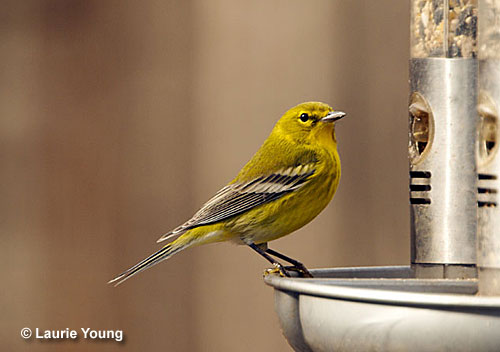
Scientific name: Setophaga pinus
Length: 5.5 inches
Weight: .42 ounces
Wingspan: 8.75 inches
Song: “swisisisisisisisisee”
The Pine Warbler is a small bird with two pale wing bars on grayish wings, broken eyerings, and a dark line through each eye. Both sexes are similar and have white spots under their tails but males are more brightly colored than females.
They are olive above, have a broken yellow eyering, and yellow and white underparts with some olive streaking. Young birds are dull, plain brownish, and lack streaks.
This species feeds on insects, other small arthropods, pine seeds, and berries. It usually forages in conifers and finds food by picking them from branches, twigs, and foliage.
Pine Warblers make a deep cup nest out of grass, bark strips, spiderwebs, and other soft materials.
This species frequents pine and mixed coniferous forests in southeastern Canada and the eastern USA including Georgia. Most winter in the southeastern states although some also winter further south, mostly in the Caribbean region.
Key Identifications:
- Small songbird with two pale wing bars on dark wings, olive upperparts, yellow and white underparts, and a broken eyering.
- Forages for insects, seeds, and berries in coniferous forest, some also visit feeders for suet and small seeds.
- Builds a deep cup nest out of grass, bark strips, and other soft materials, high in a pine tree.
- Makes sharp chip calls and sings a short, two second soft and sweet trill, “swisisisisisisisisee”.
Pine Warblers forage with other small birds in coniferous forests and are very common near pine trees and pine forests in the southeastern states. This species is one of the only warblers that mostly winters in the USA.
Brown Thrasher
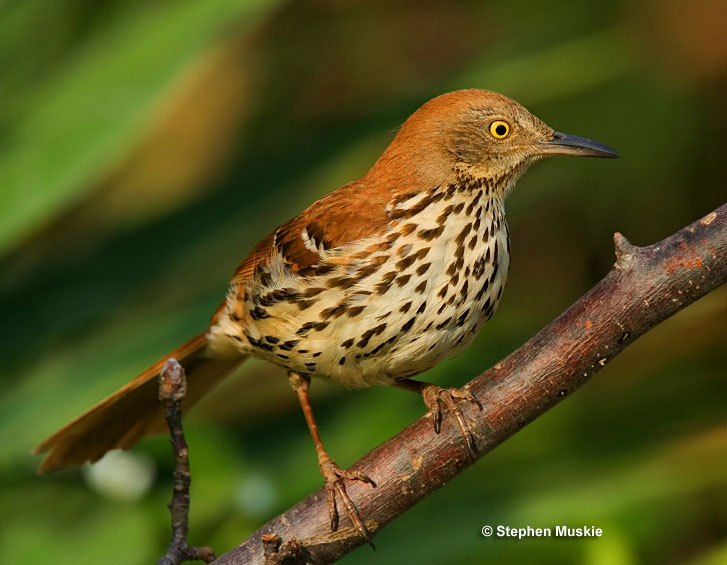
Scientific name: Toxostoma rufum
Length: 11.5 inches
Weight: 2.4 ounces
Wingspan: 13 inches
Song: “chree ree, chree ree, seerup seerup, cheer cheer, chrup chrup…”
Brown Trasher is a state bird of Georgia
The Brown Thrasher is a big slender bird with a long, rounded tail. Both sexes look alike and have bright reddish-brown upperparts, and dark brown streaks on pale buffy underparts.
They also have a grayish face, pale eyes, two narrow white wing bars, and a slender slightly curved bill.
This species feeds on insects, small creatures, seeds, and fruit. It forages by using its beak to move leaves and soil to reveal food items, and also forages in bushes and low trees.
Brown Thrashers frequent second growth, brushy areas, and other similar habitats east of the Rocky Mountains in southern Canada and the USA. Birds that nest in the northern and western parts of their range winter in the southeastern states.
Key Identifications:
- Large, slender, reddish-brown bird with a long tail and dark streaks on pale underparts.
- Forages on the ground and in low vegetation for insects, other small creatures, seeds, and fruit.
- Uses twigs and other materials to build a bulky cup nest in a low, dense vegetation, or the ground.
- Very vocal. Makes sharp smacking calls and sings a complex song of repeated double phrases that can include calls of other birds, “chree ree, chree ree, seerup seerup, cheer cheer, chrup chrup…”
Brown Thrashers are large, long-tailed reddish-brown birds with dark streaks on pale underparts. They frequent second growth and brushy areas, including parks where they sing from bushes and forage on the ground. When defending its nest, this species can peck people and dogs hard enough to draw blood!
American Goldfinch
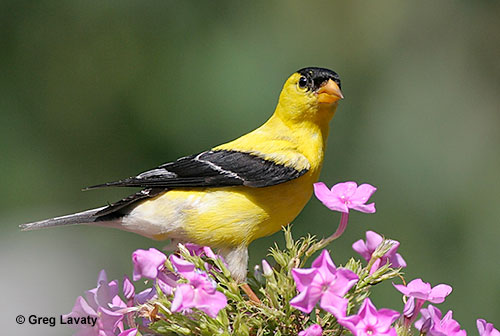
Scientific name: Carduelis tristis
Length: 5 inches
Weight: .46 ounces
Wingspan: 9 inches
Song: “swit sweet, sipsipsipchichisweetsweet”
The American Goldfinch is a small, sparrow-sized finch with a black and white, slightly forked tail, pale rump, and white undertail. In summer, males are bright lemon yellow with a small black cap, pale beak, and have some white markings on long black wings.
Females and wintering birds have two pale wings bars and have plain gray, buff, and yellowish plumage. This species often occurs in small flocks and has bounding flight.
American Goldfinches feed on seeds. They forage by picking them from grass, thistle, other low plants, Alders, and other trees. Goldfinches are also frequent visitors to bird feeders.
The American Goldfinch uses plant matter and other soft materials to build a small, tightly woven cup nest high in a shrub or a low tree.
American Goldfinches are summer residents in southern Canada, California, and the northern half of the USA, and winter in most of the USA and parts of Mexico.
Key Identifications:
- Small, bright yellow finch with a black cap, wings and tail (summer male), female and winter males are plain brown, buff, and yellowish birds with two pale wing bars.
- Feeds on seeds in low plants, trees, and at feeders.
- Makes a tightly woven cup nest high in a shrub or low tree.
- Often gives a “per chickory” call in flight and sings a short, trilled song, “swit sweet, sipsipsipchichisweetsweet”.
American Goldfinches are small, common finches that frequent weedy and brushy fields, second growth, parks, and backyards. Outside of the breeding season, they occur in small flocks and often visit feeders. Brown-headed Cowbirds that hatch in American Goldfinch nests die after a few days because they can’t survive on a diet of seeds.
Yellow-rumped Warbler
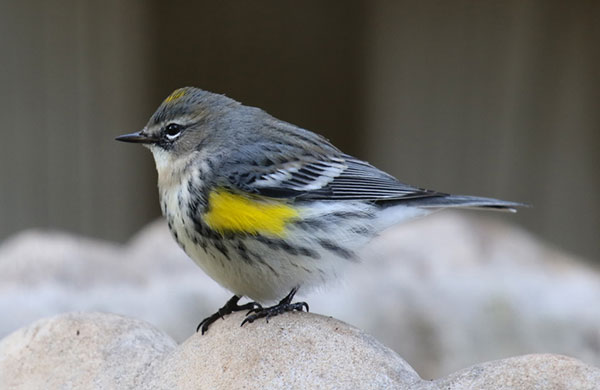
Scientific name: Setophaga coronata
Length: 5.5 inches
Weight: .42 ounces
Wingspan: 9.25 inches
Song: “si,sit,sit,sit,sit,sue,sue,sue”
The Yellow-rumped Warbler is a small, blue-gray songbird with a yellow rump, crown, and yellow patches on each side of its breast. It also has two white wing bars, dark marks on the back, and white underparts with blackish markings on its breast and sides.
In summer, this species has a blackish face and white markings above and below the eyes. Females are like males but duller. In winter, both sexes of Yellow-rumped Warblers are duller and have more brownish plumage.
The western subspecies has a yellow throat and more white in the wings.
This species feeds on insects and small berries. It picks food from vegetation and briefly flies into the air to catch bugs in flight.
Yellow-rumped Warbler build small cup nests in conifers in Canada and the northeastern and western USA. They spend the winter in semi-open habitats from the southern USA to Central America.
Key Identifications:
- Small songbird with two pale wing bars and yellow patches on the rump, each side of its breast, and crown.
- Feeds on insects and small berries.
- Builds cup nests in conifers in northern and montane forests.
- The Yellow-rumped Warbler makes a sharp call note, “chup!”, and sings a brief and easy-going warbling song, “si,sit,sit,sit,sit,sue,sue,sue”.
Yellow-rumped Warblers are small, blue-gray or brownish songbirds with two pale wing bars, and yellow patches on the crown, sides of the breast, and rump. In winter, they occur in small flocks that feed on insects and berries in parks and other semi-open habitats. The eastern subspecies is known as the “Myrtle Warbler” and the yellow-throated western subspecies is called, “Audubon’s Warbler”.
Song Sparrow
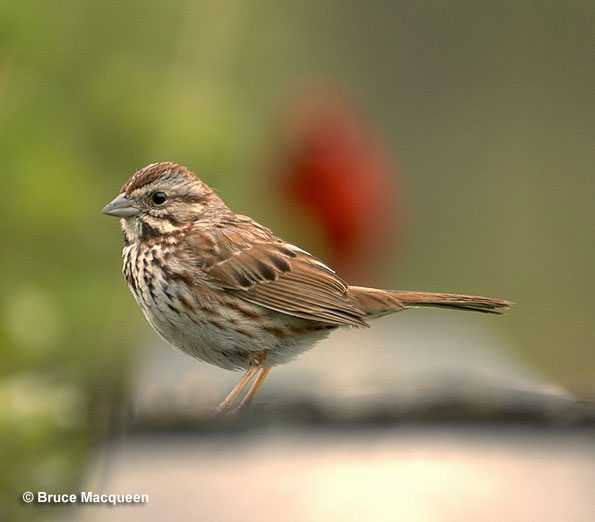
Scientific name: Melospiza melodia
Length: 6.25 inches
Weight: .7 ounces
Wingspan: 8.25 inches
Song: “seet serate sitsziziziziziziziz seet”
The Song Sparrow is a small, gray and brown, streaked songbird with a thick dark mark on each side of its white throat. Males and females look the same and have white underparts with a dark brown mark on their breast, and dark brown streaks on their breast and sides.
Most Song Sparrows also have two narrow wing bars and show a rounded tail when fluttering between bushes.
This species feeds on insects, seeds, and small fruits. Pairs forage by picking up food items on and near the ground. They are also frequent visitors to bird feeders.
Song Sparrows use grass, stems, hair, and other materials to make a cup nest placed on or near the ground. They nest in dense vegetation, shrubbery, or low trees, often near water.
This species uses a wide variety of brushy habitats in open and wooded situations in southern Alaska, most of Canada, and all of the USA.
Key Identifications:
- Small brown, streaked sparrow with a dark mark on its breast.
- Forages on and near the ground for seeds and insects in brushy habitats.
- Builds a cup nest on or near the ground in a shrub or low tree.
- Makes high-pitched “tink”, chirping calls, and has a cheerful song with a trill, “seet serate sitsziziziziziziziz seet”.
Song Sparrows are reddish-brown songbirds with dark brown streaks and a dark brown breast patch on white underparts. They usually occur in pairs and are often heard and seen in brushy areas and large gardens. There are several subspecies with distinct plumages including a large, dark one that lives on the Aleutian Islands.
Turkey Vulture
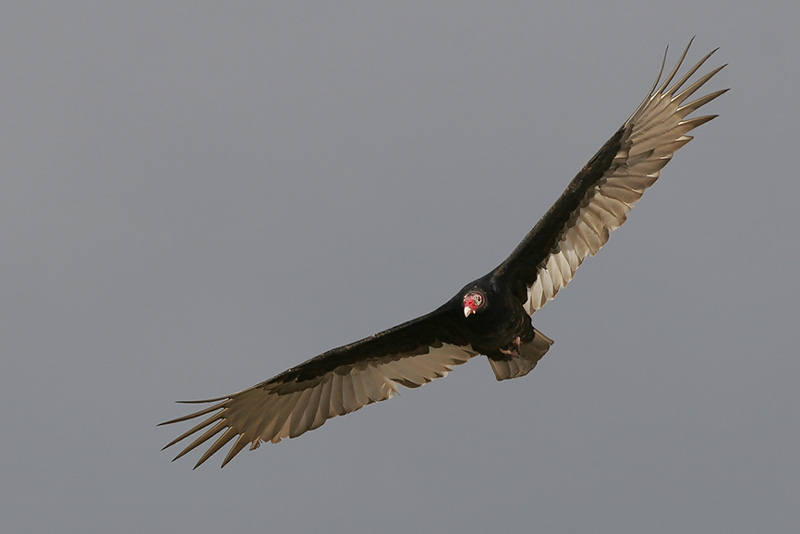
Scientific name: Cathartes aura
Length: 26 inches
Weight: 4 pounds
Wingspan: 67 inches
Song: “hisss”
The Turkey Vulture is a big, dark brownish-black raptor with a small red head and long, broad wings. Males and females look alike and also have a longish tail.
In flight, the way Turkey Vultures soar is one of the best ways to recognize them. They fly with their wings held in a “V” shape and, when gliding, often rock back and forth.
Their flight feathers are also paler than the rest of their wings but they lack the Black Vulture’s white wing patch.
Turkey Vultures are scavengers and most of their diet is carrion. They eat road kill and a wide variety of dead animals. This species forages over every type of habitat and can also fly over urban areas.
It lays two eggs on the ground in caves and hollow logs.
The Turkey Vulture lives in southern Canada and in most of the USA south to southern Argentina. This bird of prey lives in Georgia year-round.
Key Identifications:
- Big, dark raptor with a small red head that soars with long wings held in a “V”.
- Feeds on dead animals.
- Nests on the ground in caves and hollow logs in secluded areas.
- Turkey Vultures rarely call and mostly make hissing sounds at their nest.
The Turkey Vulture is commonly seen flying over every type of habitat. They are often seen on their own but can occur in flocks, especially during migration. Unlike most other birds, this species uses its amazing sense of smell to find dead animals.
Red-shouldered Hawk
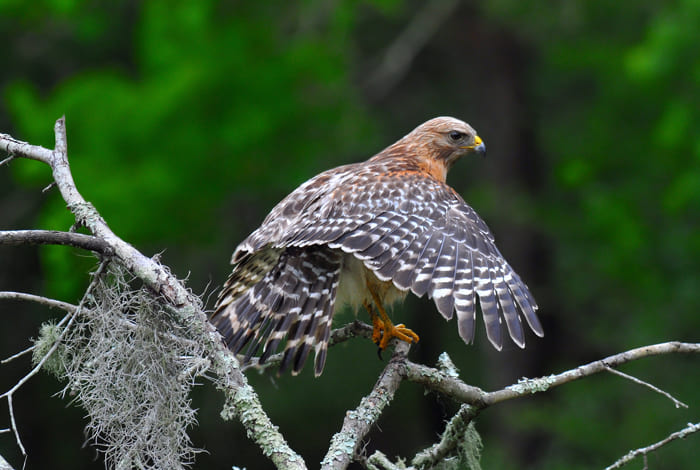
Scientific name: Buteo lineatus
Length: 17 inches
Weight: 1.4 pounds
Wingspan: 40 inches
Song: “Kyeah, Kyeah, Kyeah, Kyeah!”
The Red-shouldered Hawk is a medium-sized raptor with a black and white tail. This crow-sized hawk is dark brown and reddish above and has reddish-orange underparts.
Males and females look alike but females are larger. This hawk also has a dark mark on each side of its throat, and black and white wings with a red shoulder. Juveniles resemble adults but are brown with dark brown streaks below.
In flight, Red-shouldered Hawks have long, broad wings with a pale, crescent-shaped mark on the base of their primaries.
These raptors feed on small animals, including frogs, snakes, squirrels, and occasional birds. They hunt by watching from a perch and them swooping down to catch the animal on the ground.
Red-shouldered Hawks build a bulky stick nest high in a tree and live in hardwood forest habitats. We find them in southeastern Canada, the eastern USA, and from southern coastal Oregon south to Baja California.
Key Identifications:
- Crow-sized, colorful raptor with reddish-orange below and black and white wings and tail.
- Preys on snakes, frogs, and other small animals.
- Builds a bulky nest high in a tree.
- Red-shouldered Hawks are vocal raptors that make loud, jay-like, or even gull-like calls. They often make a repeated sound, “Kyeah, Kyeah, Kyeah, Kyeah!“, and can also make shorter “Kiyip! Kiyip!” calls.
The Red-shouldered Hawk lives in hardwood forest and other woodlands. In some areas, it is an urban bird and one of the most common raptors. Red-shouldered Hawks can join American Crows to chase Great-Horned Owls away from their territories.
Read Next: Hawks in Georgia
Frequently Asked Questions about Birds of Georgia
How many bird species are native to Georgia?
Over 340 bird species are native to Georgia. Some species appear only during specific times of the year, while others are year-round residents.
What is the most common bird in Georgia?
The most common bird in Georgia is the Northern Cardinal. This partially has to do with their willingness to visit bird feeders.
What is the largest bird in Georgia?
The largest bird in Georgia by wingspan is the American White Pelican; they have a wingspan of 110 inches. Trumpeter Swans are the largest bird in Georgia by length; they have a length of 72 inches. The largest bird in Georgia by weight is the Mute Swan; they weigh 416 ounces.
What is the smallest bird in Georgia?
The smallest bird in Georgia is the Ruby-throated Hummingbird. Not far behind the Rubby-throated Hummingbird is the Blue-gray Gnatcatcher.
What is the fastest bird in Georgia?
The fasted bird in Georgia is the Peregrine Falcon; they can reach speeds of up to 200 mph as they dive after prey.
Do starlings live in Georgia?
European Starlings are pretty common across Georgia. These little creatures stay in the state year-round.
Are blackbirds common in Georgia?
Blackbirds are common in the state, but only a few species. Red-winged Blackbirds are most commonly seen.

